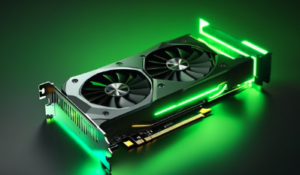Nvidia Unveils RTX 50-Series Graphics Cards with DLSS 4: A Leap Into the Future of Gaming
At the Consumer Electronics Show (CES) 2025, Nvidia made waves with the announcement of its much-anticipated RTX 50-series graphics cards. These new GPUs represent the next leap in Nvidia’s line of GeForce RTX cards, incorporating groundbreaking features that promise to reshape gaming, creative work, and AI-driven applications.
The RTX 50-series, consisting of the RTX 5090, RTX 5080, RTX 5070 Ti, and RTX 5070, leverages Blackwell architecture—a cutting-edge GPU design that offers substantial performance gains over previous generations. Alongside this new hardware, Nvidia also unveiled its innovative DLSS 4 (Deep Learning Super Sampling) technology, featuring multi-frame generation. This breakthrough technology aims to radically enhance performance, rendering speeds, and visual fidelity in video games.
In this article, we will dive deep into the Nvidia RTX 50-series, explore its technical specifications, and break down the significance of DLSS 4 and multi-frame generation in the gaming and AI spaces. By the end, you’ll understand how these new graphics cards will affect gaming, content creation, and the broader technological landscape.
The Evolution of Nvidia’s Graphics Card Lineup
Nvidia’s journey in the GPU space has been marked by constant innovation, and the RTX 50-series continues that tradition. From the initial release of the GTX 10-series to the game-changing RTX 20-series and RTX 30-series, Nvidia has continually raised the bar in terms of raw power, graphical fidelity, and AI capabilities. The RTX 50-series is no exception. With the new Blackwell architecture and the powerful DLSS 4 technology, Nvidia is setting the stage for a new era in gaming and AI acceleration.
Let’s dive into the key features and innovations behind these new graphics cards.
Introducing the Blackwell Architecture
The Blackwell architecture represents Nvidia’s latest GPU design and is at the core of the RTX 50-series. Building on the strengths of its predecessors, Blackwell introduces several innovations that aim to further push the limits of graphics and AI processing.
Performance Boosts Across the Board
Blackwell GPUs come with a massive increase in core count compared to the previous Ampere-based RTX 30-series. This increase allows the GPUs to process more tasks in parallel, which is essential for achieving the high frame rates and smooth visuals expected by gamers, creators, and professionals alike.
Compared to the RTX 40-series, Blackwell brings about a performance improvement of up to 40%. This is due to improvements in core architecture, clock speeds, and energy efficiency. These advances make Blackwell the ideal architecture for high-performance gaming, rendering complex 3D scenes, and handling large datasets in professional applications like AI and machine learning.
Additionally, Blackwell supports PCIe Gen 5, providing faster data transfer speeds between the GPU and the rest of the system. This is especially useful for tasks like real-time ray tracing and computational workloads, where bandwidth is critical.
Dedicated AI Processing Cores
The Blackwell architecture includes specialized AI processing cores, which are optimized for running deep learning models. These cores are crucial for DLSS 4, which relies on AI to generate high-quality frames with minimal computational overhead. These cores also play a vital role in enabling real-time ray tracing and AI-enhanced effects, which have become staples in modern gaming.
The architecture is designed to be highly scalable, making it suitable for both consumer gaming and enterprise-level tasks such as AI model training, data science workflows, and high-performance computing (HPC).
DLSS 4: Revolutionizing Gaming Performance
The introduction of DLSS 4 represents a major advancement in Nvidia’s deep learning technology. Deep Learning Super Sampling (DLSS) has been a game-changer for gamers, providing a way to boost frame rates without compromising image quality. DLSS 4 takes this technology to the next level by introducing multi-frame generation.
What is Multi-Frame Generation?
Traditionally, each frame in a video game is generated independently by the GPU. This process can be time-consuming, especially when dealing with graphically demanding scenes. DLSS 4 with multi-frame generation goes beyond traditional rendering by using AI to generate additional frames that were not originally rendered by the GPU. In other words, DLSS 4 can produce up to three additional frames for every frame the GPU generates, without the need for additional hardware or processing power.
The result is a dramatic increase in frame rates, especially in graphically demanding games. For example, a game that normally runs at 60 FPS may be able to achieve 120 FPS or higher with DLSS 4, making gameplay smoother and more responsive.
Why is Multi-Frame Generation Important?
This technology significantly improves performance, particularly in 4K gaming or VR (virtual reality) environments, where the GPU has to work harder to render each frame. The increase in frame rate ensures that gameplay remains smooth, even when the game’s visual effects, textures, and lighting are at their most demanding.
Moreover, multi-frame generation works alongside Nvidia Reflex, which reduces latency in competitive gaming. Reflex minimizes the delay between the action on screen and the player’s input, ensuring that gamers can react as quickly as possible during intense moments.
DLSS 4 also introduces more precise anti-aliasing, resulting in cleaner visuals and a more immersive experience. This technology will undoubtedly become a crucial component for gamers who demand high frame rates and crystal-clear visuals in modern titles.
RTX 50-Series Models and Specifications
Nvidia has launched four different models in the RTX 50-series lineup, catering to various needs and budgets. Each model is designed to offer exceptional performance while making use of the powerful Blackwell architecture and DLSS 4.
RTX 5090
The RTX 5090 is the flagship of the RTX 50-series, and it is designed for enthusiasts who want nothing but the best. With 24GB of GDDR7 memory, the RTX 5090 is built for 4K gaming, professional rendering, and AI research. The card comes with support for PCIe Gen 5 and boasts an impressive core count that allows for unparalleled performance in the most demanding applications.
Whether you are streaming your gameplay in 4K with ultra-high settings or rendering complex scenes in 3D modeling software, the RTX 5090 is designed to deliver stunning performance without compromising on frame rates or visual quality.
RTX 5080
The RTX 5080 is a slightly more affordable alternative to the 5090, offering 16GB of GDDR7 memory and a slight reduction in clock speeds. However, it still offers exceptional performance, especially for gamers looking to game at 1440p or 4K. It provides superb ray tracing performance and supports DLSS 4, allowing for higher frame rates in the latest titles.
RTX 5070 Ti
For gamers on a budget but still looking for cutting-edge performance, the RTX 5070 Ti strikes a balance between affordability and power. With 12GB of GDDR7 memory, this card is perfect for 1440p gaming or those seeking solid 4K performance without going for the most expensive model.
RTX 5070
The RTX 5070 is the entry-level model in the RTX 50-series lineup, but it still provides excellent performance at 1080p and 1440p resolutions. Equipped with 8GB of GDDR7 memory, it is perfect for gamers who want a smooth experience at high settings without spending a fortune.
Pricing and Availability
The Nvidia RTX 50-series is set to be available starting January 30, 2025, with the RTX 5090 priced at $1,999. The RTX 5080, RTX 5070 Ti, and RTX 5070 will follow soon after, with prices varying according to performance and capabilities.
Given the remarkable improvements in both performance and technology, the RTX 50-series is set to redefine what’s possible in the gaming and professional computing industries. These GPUs are expected to drive the future of gaming and AI for years to come.
Nvidia’s RTX 50-series graphics cards are poised to revolutionize the way we experience games and tackle professional workloads. Powered by the Blackwell architecture and featuring DLSS 4 with multi-frame generation, these cards offer unprecedented performance, smoother gameplay, and stunning visuals.
Whether you’re a gamer, content creator, or AI researcher, the RTX 50-series will provide the power and versatility needed to take your experience to the next level. With DLSS 4, Nvidia has set the stage for a new era in AI-driven gaming and computing performance.
As we move into 2025, Nvidia’s RTX 50-series is set to be the standard for high-performance computing, delivering incredible results in gaming, AI, and content creation alike.
Feel free to check out our other website at :aibrainpowered.com













